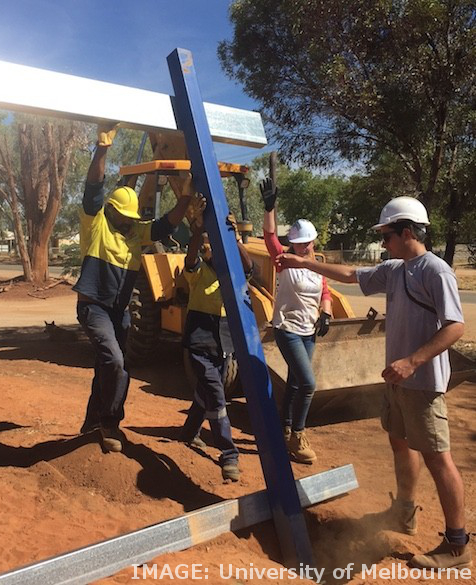Outback architecture fills local needs
 A team of twelve architecture students have travelled to the remote Indigenous communities of Areyonga and Amoonguna in the Northern Territory to build much-needed structures for the local communities.
A team of twelve architecture students have travelled to the remote Indigenous communities of Areyonga and Amoonguna in the Northern Territory to build much-needed structures for the local communities.
The University of Melbourne students built several useful structures with the support of the MacDonnell Regional Council.
The ongoing project is called the Bower Studio – named after ‘bower shelter’, a structure traditionally used by Indigenous Australians meeting together to shelter from sun, rain or wind.
The students built a bus stop and taxi shelter, a multi-purpose shade structure, and furniture such as benches and seats tailored to community needs.
Since 2008, Bower Studio participants have designed and constructed buildings including a neonatal centre, an early childhood learning centre, houses, computer labs, and community centres, in cooperation with twelve partner communities.
Project leader Dr David O’Brien, Senior Lecturer in Architecture at the University of Melbourne, said that structures such as these are vital for community health and wellbeing.
“In the central desert of Australia, a shelter will provide much relief from the heat for residents,” Dr O’Brien said.
“Currently, in order to access public transport there is no protection from the elements. What we’re doing is creating sheltered pavilions which work with the climate to create cool and shaded protection from the sun and shelter from rain” he said.
The Bower Studio is a project offered to Master of Architecture students, and focuses on environmentally sustainable and culturally relevant community and housing infrastructure.
“The aim of these studios is to develop systems and training for local communities that other building teams can replicate, providing a benefit to the community that continues long after we’ve left,” Dr O’Brien said.
Upon their return, the students will use the experience to develop their catalogue of designs, refine construction processes and outline ways to empower communities to realise their own community infrastructures.








 Print
Print